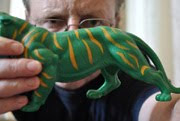
London’s Oxford Circus is shortly to get a major redesign to make it more pedestrian friendly. For those unfamiliar with Oxford Circus, it’s the intersection of Regent Street and Oxford Street – both extreme shopping zones – and the point where a crush of consumers vie for a piece of the pavement. It’s probably the busiest spot in London, and hence is a favourite hunting ground for street photographers.
All that could change shortly. The new design, based on crossings in Tokyo, will periodically stop all road traffic in all directions, and allow pedestrians to cross diagonally as well as straight ahead. Street furniture and barriers will be removed, and the area of pavement will double to reduce the pedestrian bottleneck.
When the lights give the go-ahead, the resulting pedestrian rush is known as a Barnes Dance or ‘exclusive pedestrian phase’. The Dance is named after Henry Barnes, an American traffic engineer. The scheme should be ready in time for the turning on of ye olde Christmas lights in November (yes, Christmas is in November this year).
History of Oxford CircusThe word ‘circus’, of course, derives from the Latin, meaning ‘ring’ or ‘circle’, and at Oxford Circus the term is used only in the sense that this is a roundish open space where streets meet. In short – to avoid disappointment – you will be unlikely to find any clown-based or high-wire entertainment activities at this location.
If its true cultural significance could be measured by its Wikipedia entry, the current entry stretches to just four complete sentences. I would guess (note the level of research here, Peter Ackroyd look out) that the widespread recognition of its name is only because it marks the point where streams of shoppers from the clone stores of famous Oxford Street meet the shoppers exiting famous Regent Street, and then bump into the people emerging from the functional Oxford Circus tube station. In other words, it’s famous solely for being a crowded pedestrian roundabout.
The new design certainly sounds like ‘a good thing’, although street photographers may have to adapt to the dance.



